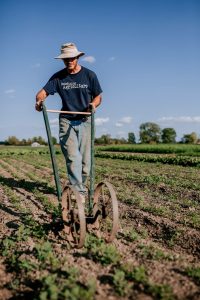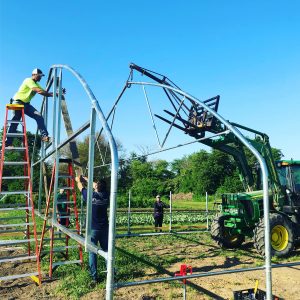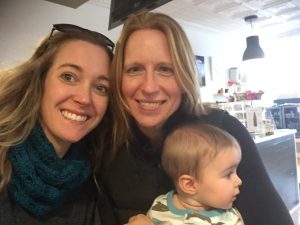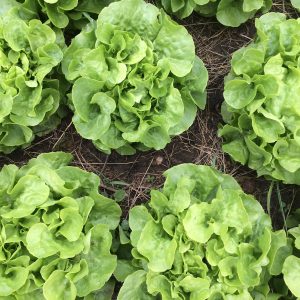What Your Farmers Will Be Doing This Winter…
Now that the CSA is coming to a close, you may be wondering what kinds of things your farmers will do all day…
After all, we do get the winter off, right?
Well, not exactly.

Farmer Kurt will be prepping beds for this winter.
Don’t get me wrong. We do plan to sleep in and watch some movies. But the work plows on — just a different kind of work with a much slower rhythm. There is after all, a lot that goes on behind the scenes in the off-season to make the next summer CSA flow like a well-oiled machine.
The “off-season” lasts from mid-November through early April, when things pick back up again full-steam.
To help keep us on track, we have a “rolling calendar” — which is a 5 page Word document we print out and attach to our kitchen wall — listing all the tasks we must complete each month. And it includes everything from “prepare W-2’s” to “inventory the bins and buy replacements.”
But here’s a break-down of some of the bigger tasks we work on in our 4 month “off-season.” Although I can’t list them all for the sake of space, this list will at least give you an idea of the other tasks a small business like ours walks through each year.
High Tunnel Completion
This year we were the recipient of one of the coveted USDA EQIP grants to build a “high tunnel.” High tunnels look like greenhouses, but they are erected over soil (not gravel ground), so that farmers can plant underneath in protected, warmer conditions.
If you remember, we did actually complete stage 1 of this process this summer. But we still need to build walls and cover it with plastic.
This is our top priority in the next months due to cash flow. We have to upfront the cost of the high tunnel and only receive the grant once we complete it.
Clean Up & Winterize Farm
Kurt washes down all the equipment, all the harvest bins, organizes the barns and greenhouses, and stores everything we can under cover. We also close down one of our two walk-in coolers. And we inventory EVERYTHING — so we know what needs to be replaced and repaired in the off-season.
Pop Up Markets & Thanksgiving Share
We still have a few winter items hanging out in the field for our Thanksgiving share. We’ll also be offering extras to YOU in our occasional “pop-up” markets. (You place an order online, and meet us at a designated pick up window to get it). Things like spinach, Brussels sprouts, Romanesco, kale, onions, and carrots.
New Greenhouse Up
 We do still plan to grow a few things through the winter for our chefs and pop-up markets — most notably our carrots and spinach. These items must be grown under greenhouse cover — small “low tunnel” hoop house structures. We’re also replacing our greenhouse with a bigger one, which means we need to disassemble, level and prep the new space, and erect the NEW permanent greenhouse we bought last year. This should dramatically increase our “nursery” space for growing transplants and curing onions/garlic.
We do still plan to grow a few things through the winter for our chefs and pop-up markets — most notably our carrots and spinach. These items must be grown under greenhouse cover — small “low tunnel” hoop house structures. We’re also replacing our greenhouse with a bigger one, which means we need to disassemble, level and prep the new space, and erect the NEW permanent greenhouse we bought last year. This should dramatically increase our “nursery” space for growing transplants and curing onions/garlic.
Equipment/Facility Maintenance
Also known as the “farm honey-do list.” Every year, there’s something big that needs to be fixed. And winter time offers the perfect time to do it. Kurt makes a list of facility or farm equipment that needs to be repaired, and he either does it himself, or contracts someone else to do it.
Planting Garlic, Compost Application, & Bed Preparation
Garlic is always planted around Halloween, and is the final task for our paid crew. Kurt will also spread leaf mulch and compost on our fields to feed the soil. And he erects the vegetable beds for next season with the tractor and bed-maker out in the main fields. That way, come spring, when ideal planting conditions arrive, he can jump into the field and start planting, and not have to wait several days to first create the bed structure.
Transitioning to Wholesale Production
As we enter our 12th season, we are beginning to talk about an “exit strategy” for our farm — aka retirement. Although this is about 20 years away, we can already tell that we’ll need to shift our product line in the next 10 years in case our bodies physically can’t do it anymore. CSA is a very intense form of farming, and we have been looking very seriously at developing a wholesale side to the business, so that we can be ready to make a shift when necessary. This involves leasing and purchasing more land, moving it into organic production, monitoring our crop rotations, rethinking our staffing needs and cash flow. This next year we will begin to baby-step into this direction with a pilot project, and slowly scale it up as we learn the ropes.
Planning for Next Season

I’ll be meeting with Cadie (left) to plan next year’s teaching strategy for our facebook group.
This has several layers to it. It starts with reviewing the end-of-year surveys and harvest yields/notes. Kurt and I spend 2 days in early November on a planning “retreat” reviewing the data, evaluating the year, discussing staffing needs and work flow, and brainstorming new opportunities for our business. We identify the pain points for us and our customers and try to figure out ways we can solve them. This retreat is usually a very “high level” discussion. We plan a second retreat in February where we make the final decisions and map everything out on a calendar to get an idea of our new work flow.
We also spend several days analyzing our budget and finances. We calculate our income goals, cash flow and build out our expenses from there. Kurt always has a “wish list” for capital improvements, and so we make some decisions about what equipment or facility maintenance needs to happen this year.
Replace the Well Pump
This is a pretty big capital expense — to the tune of $30,000. But it’s absolutely necessary to secure our farming future. The well we currently use is on our parent’s adjacent property, and it’s been giving us some issues this year — inconsistent pressure and strange noises — all the signs that it’s on its last leg. The last thing we need is for the well to go out in the middle of the season when we need it to work. Parts for the current well are extremely hard to come by and would take 2 months to fabricate — by that time, our crops would be dead. As a result, this item has jumped to the top of the capital expenses list this year. We plan to upgrade it with a submersible pump, a state of the art system that can even be controlled remotely by phone, saving Kurt some valuable time as well. Because of the cost, our parents plan to split it with us, but it’s still a heavy hit.
Purchase Shipping Container
Another big item on the wish list is a giant storage container. Our farm is really strapped for adequate storage units to store our harvested crops. It’s one of the reasons our winter squash rotted so quickly because we only have a covered greenhouse and wash bay area to stage these items. Having another large cool area to put our root crops, winter squash, tomatoes would help us be able to minimize waste. This is also a pretty big investment. This used to be #1 on the wish list, but the well issue may make this something we have to put off another year.
Production Plan & Field Maps

We’ll be thinking through new crop varieties so we can place our seed order.
Kurt spends hours pouring over the planting production plan each winter. And I mean HOURS. It starts with mapping out a harvest plan for next season for each week of the year. What will your box look like on any given week? And then reverse-engineering it to determine what seed to buy, exactly when to start planting it in the greenhouse so it’s ready on time, and when to transplant it.
We also meet with our local chefs to get feedback for next season, and these requests also go into the production plan. We make our commitments to our wholesale accounts, and put that on the plan. Plus, we take a rough look at what sold at the farmer’s markets really well, and are sure to bump up the production to accommodate those needs.
Kurt also makes a giant field map showing where everything will be planted. With limited acreage, we do after all have to make sure it all fits and that we honor the need for certain parts of the land to “rest.” Organic certification also requires that we practice “rotation” — i.e. not planting the same type of crop family in the same place year after year. Knowing what will lie fallow and where he can place certain crops is a special dance that only Kurt fully understands. This is kind of like playing “Tetris,” and every inch of real estate soil is precious. Sometimes crops get dropped on the editing floor because they simply don’t fit or they don’t make us enough money to be worth the space.
Seed Order
This gets its own category, because it’s such an enormous undertaking. Once Kurt decides what he’s going to plant, he then has to decide WHICH VARIETY of seed he’s going to use. Out come all the seed catalogs which he pores over, looking for new “features” or characteristics of seed variety. After 10 years of experimenting, we’ve found some old standbys that we can trust, but we always have a few veggies that we are trying to get better. Our seed choice decisions largely depend on three things: taste, yield/germination rate, and bug/disease resistance. Greenhouse seeding for onions begins in February, so this order is usually placed before the New Year. And it’s one of the big expenses we have on the front end.
Vacation
Ah yes, let’s not downplay the fact that do take some intentional time off. This is after all, the chance we have to go on adventures with the boys. We will use Spring Break, Thanksgiving, Christmas break, and long weekends to go on adventures with Jed and Josiah. These are holy moments for us — time away from the farm to stop thinking about the business and remember our most important vocation: to be parents.
Content Creation Plan
I’ll be working with Cadie on a plan for the winter months in the Private Facebook group. I’ve got a few challenges in mind already to help keep our members engaged and growing. We’ll be evaluating what were the big winners last season, re-packaging the content we already created, and deciding what needs to be updated or added to in the Academy. Your survey responses will be really helpful here.
Marketing Sales Plan
By October 21, we should have a good idea of our retention rate, thanks to our aggressive early-bird marketing push. With these numbers, I can head into the winter with a good idea of how many spots I still need to sell in our CSA. I spend many weeks designing ways for potential customers to find out about our brand. And I devote hours and hours of creative energy engineering the “journey” a potential customer takes once they first stumble upon us.
For example, I build “lead magnets” (things that customers will trade their email address for) and content giveaways for our website, blog, and Facebook page, which then guide people into a pre-written email “drip campaigns” — all designed to help a customer get to know our farm, what we offer, and see if they’ll be a good fit for us. I also create a pretty elaborate video/teaching strategy to pull in CSA Leads for our CSA Sign Up push in April. And I write some kind of weekly content — either blogposts, videos, or emails all winter long, to help keep our audience engaged and learning.
We’ll open registration to the public for our CSA October 24-31. So that will be a very heavy promotional week for us. We hope to close the gap and get to 80% full with this push.
Accounting
You would be surprised how much time is spent on weekly book-keeping and accounting — even in the winter. Tracking down unpaid bills, cleaning up the books for years-end, and logging all the CSA deposit payments is part of the winter to-do list.
Research and Continuing Education
Finally, winter is our time for learning. Kurt and I are both big believers in “sharpening the proverbial ax” to keep our business on the cutting edge. Kurt reads farming and soil science books for fun, and we’re always trolling YouTube for innovators in the field. We’ll attend the MOSES farming conference. And I’ll be leading a seminar for farmers on how to scale up their marketing campaigns.
Wow. Now that I’ve written that all down, I’m kind of exhausted just thinking about the off-season. Are you?
Who am I kidding? You and I both know farmers can’t sit still for long. We’ve always got to be working on something. But don’t worry:
We’ll be sure to visit lots of restaurants and dine like kings with our favorite chefs. And binge-watch some Netflix…
